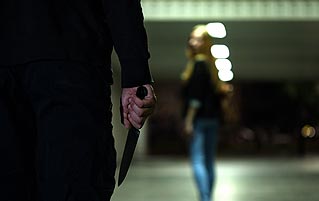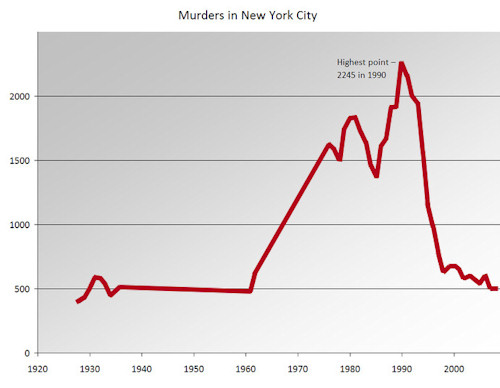When Life In New York Was A Real-Life Dystopian Action Movie

Ever met an old person who is just scared to death of street crime? Like, they're always warning you not to walk home alone because "gangs" might attack you, even though you're walking through a gentrified neighborhood full of dog-friendly restaurants? Well, it might be because they lived through this:

That red line is the utter massacre that broke out in New York late in the 20th century. Over the course of 20 years, murders went up more than 400 percent, and other violent crime followed suit. Scenes from New York streets and alleys filled the nightly news across America, a whole nation afraid this was their future.
The epicenter of NYC's crime wave was the subway system, at the time one of the most dangerous places in America and the setting of countless gritty Hollywood crime dramas. We talked to Arnold, who was an MTA worker in the '70s and '80s, about what things were like at their worst.
1970s New York Was Almost Dystopian
When 1970s films wanted to show that New York was a hellscape, they took their cameras to the subways. The Warriors, The Taking Of Pelham One Two Three, Midnight Cowboy, Death Wish, and The French Connection are but a few well-known examples. It'd be easy to think now that it's all set dressing, since it comes off like a retro version of RoboCop's Detroit. But it wasn't exaggerated that much.
In fact, some of the trains in the movies look quite a bit nicer than what Arnold worked on. He claims that when broken/wrecked cars were pulled off the line, people would still try to board them. "You know why? Because they couldn't tell the difference ... It was at a repair yard at Coney Island. People just got on and then complained to us when the train didn't move." But of course, in those movies, the danger wasn't the cars' state of disrepair -- it was the threat of getting your ass mugged and/or murdered. That, also, was not the product of any screenwriter's imagination.
"I knew a little old Jewish man who would sit every day in the back of one of the trains," says Arnold. "He had The New York Times and would happily read on his way to a Jewish community center ... Every day he would sit there, and right next to him, in this cloth briefcase, was a giant knife. Like a machete." A conductor told Arnold that he once saw the guy brandish it, scaring away two youths by threatening to chop their hands off.
This, Arnold says, was not uncommon. "Women had hair and hat pins I saw them holding when someone near them got boisterous. Businessmen in suits, I would hear audible thuds from their pants when they sat down -- obviously a gun or some heavy object."
And the riders weren't just being paranoid.
Gangs Were Everywhere
Hollywood insists that flamboyant street gangs populated the streets of 1970s New York, as seen in The Warriors, which, uh, probably doesn't convey the terror of the situation:
Now, roving gangs didn't really wear whimsical themed costumes like they do in that movie, but they did rove. Gangs with names like the Satan Souls, Black Attacks, T&T Bachelors -- New York had them all. When cops cracked down and chased the gangs off the streets, they went the one other place they could: the subway. Overnight, felonies committed in the subway system shot up to 250 a week.
For reference, that's more than 500 percent more serious crimes than there are total crimes on the subway today. Murders on the subway were in the dozens each year -- by 1979, there was about a murder a week. As for what Arnold saw ...
"The worst was on a car on the Lexington Line. Someone had disagreed with a known drug dealer and shot him. We had to switch trains, since this particular one was going to be out for awhile. I rode on it on the way to the yard. Now, the blood had come out in streaks. It's not that huge blotch you see on TV. It looks like paint coming down in lines ... There was enough on the one clear window in the train that when the sun hit it, it briefly made the interior a reddish hue. I had been OK previous to this -- I was used to bodies and all matter of fluid. But when that happened, and 'murder' finally hit me as the cause, I puked in there."
Note his comment about how corpses were nothing new ...
Finding Dead Bodies Was Not Uncommon
Not every corpse was a murder victim. People found plenty of reasons to die on a train car. "We had deaths every week on the lines I worked on ... junkies would find an alcove, or emerge from inside the tunnels , get in and die right there." He says the police would come, shuffle the body off the car, and let them get back to picking up passengers.
"... There had been so many complaints about this certain car that I was sent down to take a look. We thought maybe an animal had died and was lodged somewhere. It turned out to have been a junkie. He was slumped in the back, so it looked like he was sleeping. He had been there for days ... Conductors are supposed to sweep through, but they either missed him or didn't do it. The medical crew who came had to carry him out in that half-curled-up position because rigor mortis had set in. We needed to get him off quickly to clean up, so they literally carried him out like a statue."
And sometimes shit got too creepy for the gangs. Arnold describes a bunch of gang members scrambling out of a subway car to report a corpse they'd stumbled across. "When I got down there with paperwork, they were all sharing coffees. Some of those gang members were shaken up. I thought these were hardened criminals, but they were teenagers who had mostly never seen a dead body before. And the police officer was comforting them."
Related: 6 Horrifying Things You Learn As An Inmate On Death Row
Sometimes, Gangs Just Took Over A Train
"After Taking Of Pelham One Two Three, we actually did have some attempted hijackings" Arnold said. "Most of these happened in the late '70s ... they would barge in, take the conductor to the side, and proceed to the next station." As in, they would take over driving the train. Like, imagine you're on your way to work and see a gang walk past you, up to where the conductor is sitting, then they just ... take over the controls.
"They did it partially to 'make their mark,' like they were showing ownership ... I stepped on a train and saw all of these Satan Souls members get out. I checked in with the conductor and he said, 'It happened again, Arnold!' The police cracked down on that pretty hard the following year -- that really is crossing a line -- though hijackings still occurred every now and then for some time after." Fun fact: In 1980, a 15 year-old kid took over a train and drove it for six stops. He wasn't in a gang, he just really liked trains. It was a system in chaos, is what we're saying.
Citizens started avoiding the subway altogether (ridership dropped by more than 20 percent over a decade). Lack of staff and resources meant that people like Arnold just had to turn a blind eye to anything that wasn't life or death. "Unless it was an emergency, we weren't going to stop. Murder, grievous injury, deaths, someone falling on the tracks were stoppable reasons. What wasn't was, say, fighting. Or some guy getting handsy with someone. Or graffiti ... If you were alone, and two robbers came on and you were robbed, I don't know of any conductor who would go out of their way to do something about it. I would call it in and get police, but that's it."
Arnold knew better than to intervene in the minor stuff. He had a colleague who got stabbed trying to stop graffiti artists. Usually they didn't even stop painting when they saw MTA workers came by. "I remember seeing Sesame Street's Christmas episode. The part where they all go on the subway came on ..."
"There is no reason why they should have gone through unscathed," he remembers thinking. "Where was the graffiti? Where was the guy ready to start stabbing people? If you ever needed to prove to your kids back then that Sesame Street wasn't real, just show them how the subway looked then. A group of people like that, even without puppets, would have been a muggers' dream at the time."
You'd actually think the living puppets would freak them out a little, but you get the point.
Related: Your Neighbors Try To Murder You: 6 Realities In A Genocide
And Then, Something Very Strange Happened
In a dystopian film, the whole point is that things are falling apart and will continue to fall apart. Anyone riding those subways in Arnold's day could easily assume that New York wouldn't even be a city at all by the year 2000, just packs of gangs and terrified victims. (1981's Escape From New York took place in 1997, and seemed somewhat plausible at the time.) In real life, well, let's extend our original graph a couple of inches to the right:

After 1990, crime plummeted faster than it had risen.
You could argue that things reached a symbolic boiling point in 1984, when a guy named Bernie Goetz whipped out a revolver and shot four people threatening him on the Subway, and instantly became a national symbol for a citizenry that was fed up with crime. The ensuing drop in violent crime would be nationwide, and was so sudden and dramatic that experts aren't sure why it happened. Theories range from tougher policing to legal abortion to even reduced lead poisoning.
As for New York's subways, they poured nearly $2 billion into the system in just a few years. They hired 2,000 staff solely to clean graffiti, an intensive process which itself took years (they held a special ceremony in 1989 to celebrate the cleaning of the final car). "When I left, most of the trains were clean," says Arnold. "Everything was new, or seemed new."
By the 1990s, crime was vanishing from the subways, and by the 2000s, it had become a model system. There was a dystopian nightmare, then people got sick of it and fixed that shit. When's the last time you've seen that in a movie? The good guys just straight cleaning up a dystopia?
We're not bringing this all up out of the blue. These days, those subways are in need of repair again, triggering a bitter public argument over funding. And the national mood seems to be that society, in general, is in the process of falling apart and can never be put back together. But historically, that's simply not true. Where there exists enough will (and cash), things can be cleaned up and repaired, restored to their former glory. Problems are, in fact, solvable.
Just ask anybody who rode the New York subway in 1978.
If you loved this article and want more content like this, consider a visit to our Contribution Page. Please and thank you.
For more, check out Why The Cops Won't Help You When You're Getting Stabbed:
The first-ever Cracked Podcast LIVE TOUR is coming to a city near (some of) you this spring! Tickets on sale now for Chicago IL (April 11th) and St. Paul MN (April 12th).
Follow us on Facebook. Because we love you.